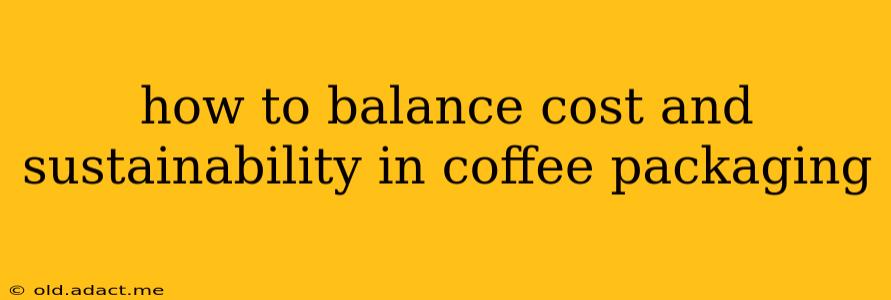The aroma of freshly brewed coffee is a beloved ritual for millions, but the journey from bean to cup often leaves a significant environmental footprint. Coffee packaging plays a crucial role in this journey, presenting a complex challenge: balancing the need for cost-effective solutions with the growing demand for sustainable practices. This comprehensive guide explores how roasters and brands can navigate this delicate equilibrium.
What are the Key Sustainability Concerns in Coffee Packaging?
The coffee industry faces considerable pressure to reduce its environmental impact. Traditional packaging materials, often petroleum-based, contribute to pollution and greenhouse gas emissions. The disposal of these materials, particularly non-recyclable plastics, adds to landfill waste and marine pollution. Furthermore, the energy consumed in the production and transportation of packaging materials contributes significantly to carbon emissions. Choosing sustainable options directly impacts the industry's environmental responsibility.
How Much Does Sustainable Coffee Packaging Cost?
The upfront cost of sustainable packaging is often higher than conventional options. Materials like recycled paperboard, compostable films, and even reusable containers carry a premium. However, several factors need to be considered:
- Long-term cost savings: While initial investment might be higher, sustainable packaging can reduce long-term costs through waste management programs, reduced disposal fees, and improved brand reputation.
- Supply chain optimization: Building relationships with suppliers who offer bulk discounts or sustainable sourcing initiatives can mitigate some cost increases.
- Government incentives: Many regions offer incentives and tax breaks for businesses adopting sustainable packaging practices.
What are the Most Sustainable Coffee Packaging Options?
Several eco-friendly alternatives are gaining traction:
- Recycled paperboard: A widely available and relatively cost-effective option, particularly when sourced from responsibly managed forests. It's easily recyclable and often compostable.
- Compostable films: These films are biodegradable under specific conditions, minimizing landfill waste. However, their availability and cost-effectiveness can vary.
- Reusable containers: While more expensive initially, reusable containers offer significant environmental benefits over single-use packaging. They require a robust return system, which can add to logistics costs.
- Bioplastics: Made from renewable resources like cornstarch or sugarcane, bioplastics offer a sustainable alternative to traditional plastics. However, their compostability and recyclability vary significantly depending on the specific type.
What are the Trade-offs Between Cost and Sustainability in Coffee Packaging?
The choice of packaging often involves compromises. For example:
- Recycled content percentage: Higher recycled content usually translates to a higher price, but it significantly reduces the environmental impact. Finding the optimal balance between cost and recycled content is crucial.
- Packaging design: Minimizing the amount of packaging material used can reduce both cost and environmental footprint. Clever design can achieve this without compromising product protection.
- Transportation: Choosing packaging that's lightweight and efficiently packed for transport reduces fuel consumption and emissions.
How Can I Reduce the Environmental Impact of My Coffee Packaging?
Beyond material selection, various strategies can improve sustainability:
- Partnering with a responsible supplier: Collaborating with suppliers committed to sustainable forestry, responsible sourcing, and ethical manufacturing practices enhances overall sustainability efforts.
- Implementing a closed-loop system: A closed-loop system involves collecting and recycling used packaging, significantly reducing waste. This often requires investment in infrastructure and logistics.
- Educating consumers: Inform consumers about the sustainability features of your packaging and encourage proper disposal or recycling.
Are There Any Government Regulations or Incentives for Sustainable Coffee Packaging?
Many countries and regions are implementing regulations to reduce plastic waste and promote sustainable packaging. These include bans on specific types of plastic packaging, extended producer responsibility (EPR) schemes, and tax incentives for businesses using sustainable materials. Research local regulations and incentives to leverage support for sustainable packaging initiatives.
Can I Make My Coffee Packaging More Sustainable Without Increasing Costs?
While completely eliminating cost increases may be difficult, there are ways to minimize them:
- Negotiate with suppliers: Explore bulk discounts and long-term contracts to reduce per-unit costs.
- Optimize packaging design: Streamline designs to minimize material usage without sacrificing product protection.
- Explore alternative sourcing: Investigate less expensive, yet still sustainable, materials.
Balancing cost and sustainability in coffee packaging requires a holistic approach. By carefully considering material selection, supply chain management, and consumer engagement, coffee businesses can minimize their environmental impact without compromising profitability. The long-term benefits – a reduced carbon footprint, enhanced brand reputation, and potentially reduced costs – far outweigh the initial investment in sustainable practices.
